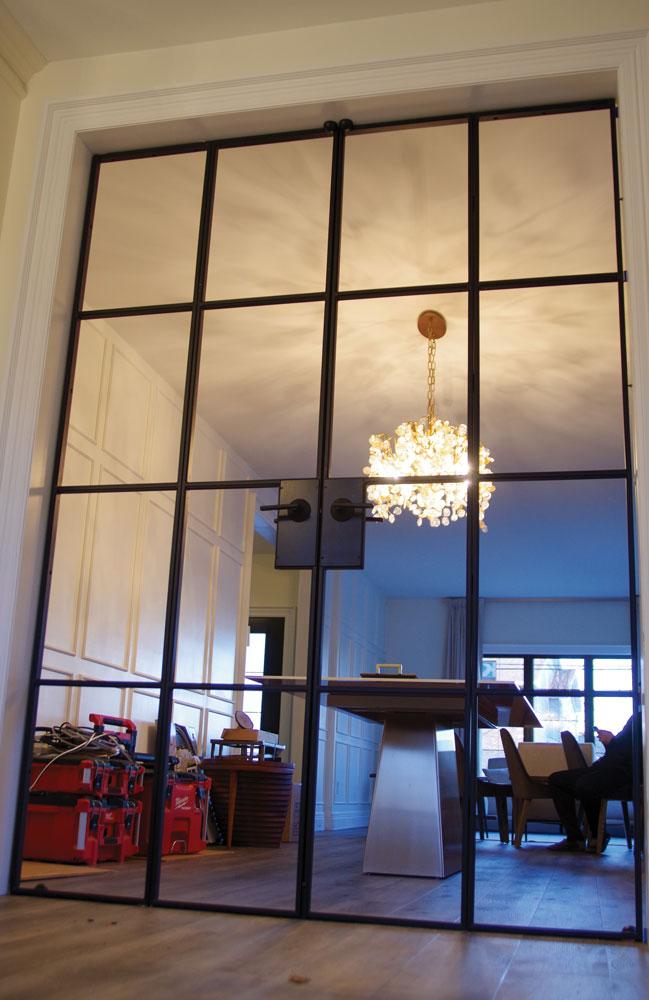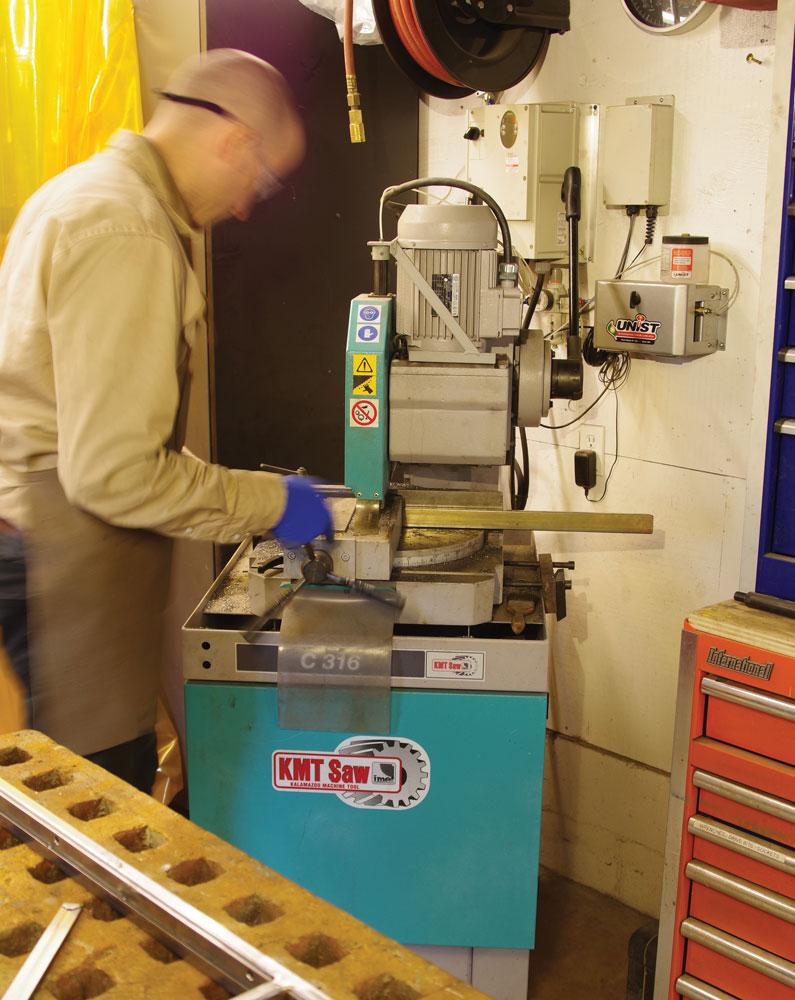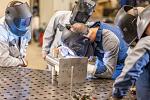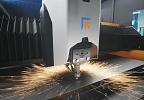Associate Editor
- FMA
- The Fabricator
- FABTECH
- Canadian Metalworking
Fab shop finds a good fit
New KMT cold saw gives Charles Street Metalcraft more flexibility
- By Lindsay Luminoso
- January 26, 2022
- Article
- Fabricating

Since Fin Macdonald purchased a KMT C 316 cold saw last year, he has been surprised by how easily he can cut stainless, aluminum, and mild steel on it. Images: Charles Street Metalcraft
Fin Macdonald got his start as an industrial welder in the Halifax area. As a member of UA Local 56 Plumbers & Pipefitters, he apprenticed at Aecon Atlantic. After completing his Red Seal qualification at Aecon, he moved with Local 56 to the Irving Shipyard. When his first child was born in January 2018, Macdonald realized his dream of opening a small business.
“I really rethought my work-home life,” said Macdonald, owner of Charles Street Metalcraft, Halifax. “I wanted a job where I could meet my partner for lunches or take time off when it made sense for our family. I decided that I wanted to work for myself, so I did a crash course in how to run a business through an organization called the Centre for Entrepreneurship Education and Development (CEED). I had been putting together my shop as a weekend warrior while working at the shipyard, so it was possible to transform it rather quickly into Charles Street Metalcraft, a full-time fabrication shop, which has continually grown over the last few years.”
The shop is in a residential neighbourhood on the Halifax Peninsula, where Macdonald lives with his family. He is the sole owner and operator. One of the advantages of his home occupation-based business is that he can roll operational costs into the cost of his mortgage while also minimizing overhead and daily costs.
“I can operate quite leanly here,” he said. “I can work flexible hours. I often work on weekends and late nights, and I don't have any additional employees right now. I offer design work via SketchUp and a willingness to take a job from scratch and work it up right to installation. I'm a one-stop operation for custom, residential, and semi-commercial fabrication. And not only that, I’m thrifty with how and where I spend my time and money and I feel like I've made good choices in terms of the equipment I’ve invested in.”
Operations
While there are a number of excellent shops in the area, Charles Street Metalcraft has carved out a niche market fabricating fixtures, fittings, railings, gates, and other decorative architectural components all the way from design work to part installation. While his competition and larger shops in the area have to contend with the high rents for industrial spaces, Macdonald’s at-home shop allows him to stay lean, small, and flexible.
“I don't have the added costs of tooling or large overhead associated with other fabrication operations,” said Macdonald. “The level at which I pitch is much more hands-on and it works for me. I have been able to maximize the capacity of my small space through operating as a one-man operation and making good decisions about what kinds of projects to take on, what kind of equipment is going to work in my shop, and what’s going to pay off over time.”
Macdonald works almost entirely in mild steel, although he recently took on a job requiring aluminum and has worked with stainless steel from time to time.
“I don't work with large material because I'm limited by my material handling capacity,” he said. “So, for instance, my shop space doesn't have access for a forklift, but I do have a small jib crane. I have to be able to move things well by hand from my shop out to my vehicle and then on to the site, so I try a keep it small. I tend to work with sub 4-in diameter tubes and sub 1-in. solids.”
For larger jobs, Macdonald is able to break down the project into assemblies and move each segment to install in sections. Right now he is working on a project using 3.5-in. square galvanized tubing that is sectioned into two subassemblies. However, his next project is a set of delicate French doors in rectangular, 0.5- by 1.5-in. CREW tubing. He also works with 0.5-in.-diameter solids for railing work and some structural shapes like aluminum U- channel with lengths up to 10 ft.
“About two years ago I started to look into investing in a saw for the shop,” said Macdonald. “I wanted to get away from an abrasive chop saw situation, whether that’s a grinder using a zip disc or large diameter abrasive, for both safety and cleanliness reasons. These kinds of saws are messy, and because I have a small shop, it just didn’t make sense. And as a home business, I don’t yet have the benefits package that would allow me to take time off if injured, so safety was a big concern. And because I work in a residential neighbourhood, I needed something fairly quiet.”

For larger components, Macdonald breaks down the project into assemblies. This set of delicate French doors was recently delivered to the customer and installed.
The French doors project, which requires a ±0.125-in. tolerance, pushed Macdonald to aspire for higher precision to guarantee accuracy with every cut. The shop initially had a band saw, but with floor space at a premium, the width and swing of the equipment was a problem, as was the need to continually invest in new band saw blades.
“What I was demanding from it and the speed at which I was demanding seemed to be pushing it to the limits,” said Macdonald. “So I started to look at a cold saw. There was an offering through a company here for a cold saw on a pivot, but its cutting capacity and its footprint were just a bit big and did not offer the quality that I was looking for. That’s when I decided to work with Kalamazoo Machine Tool (KMT). I wanted a smaller footprint that takes advantage of the vertical space more efficiently.”
Fin added that while some shops may not look to U.S. suppliers or purchasing equipment that needs to cross the border, KMT made sure the process was seamless.
The Cold Saw
For all of these reasons, Macdonald purchased a KMT C 316 cold saw about a year ago. A number of additional factors made this saw ideal for the size of the shop and the jobs it would be used for.
The saw itself has a solid base to which ratcheting levelling casters can be mounted. Such casters enable the saw to be aligned quickly with portable infeed and outfeed tables and allow the saw to be tucked easily right against a wall and be pulled out when needed. Those features appealed to Macdonald.
He also factored in lubrication.
“Because of my small space, I can't deal with water-based coolants because it would just get too messy in the shop, splashing on my tool cabinets and rolling down longer tubes, spilling out the other end,” he said. “I didn't want to deal with that kind of mess, so I needed a saw where I could easily apply a minimum quantity lubrication (MQL) system to apply a microspray of lubrication.”
For the most part, flood coolant is used on a band saw to maintain blade life. And while flood coolant was an option on the KMT saw, Macdonald configured it with a Unist MQL system. A flood coolant system requires maintenance and fluid recycling, which can be both time-consuming and costly.
“The saw has been in operation for about a year now, and while you wouldn’t want to do this in a production environment, I was pleasantly surprised by how easily I was able to cut stainless, aluminum, and mild steel,” said Macdonald. “As long as I choose the blade carefully, I can run it at the same speed and it cuts well. The only thing I have to do is change the blade once per year. I don’t have blades breaking and I can have them resharpened locally. I don't have the additional downtime. It’s really great. It’s definitely a saw that I can continue to grow my shop with.”
Macdonald said that this type of saw is usually seen in production settings for batch cutting and high-volume runs, but that is not the case with his saw. And while it is not cutting the high volumes, it provides him with the peace of mind that whatever job comes along, as long as the dimensions are kept reasonable, it can mitre it. Macdonald said the saw also has an excellent sliding anti-burr vise.

Macdonald recently has been working on a delicate French doors project that requires tolerances of ±0.125 in. The saw can achieve a tighter tolerance of ±0.0625-in. over 95 in.-lengths.
“It’s far exceeded my expectations in terms of versatility and ease of maintenance,” he said. “There's only so much high-quality equipment available at kind of an entry level, and that was one of my frustrations. But a small metal fabrication operation shouldn’t be able to invest only in something finicky or lightweight. I would strongly consider a higher-end tool like the one I have, not just because you're getting an excellent saw, but for all the features and flexibility it offers.”
For a small operation that might not have access to industrial 3-phase power, the saw runs off of a variable-frequency drive so it can run on a single-phase, 240-V configuration. Choosing a saw that can easily integrate into the current workspace with no significant modifications was important to Macdonald.
“I think having good equipment that I can count on, that's not going to cost a lot to operate, is so important,” said Macdonald. “It was really important for me to make room in my budget for quality equipment, which has made my shop experience really pleasant and safe. It also makes me want to go out to my shop, not procrastinate about fixing a blade or cleaning up a lubricant spill; there’s nothing to worry about except taking that next cut.”
Future Opportunities
This last year Charles Street Metalcraft has increased its business twofold and is constantly booking farther and farther out.
“I'm booking into spring next year now for jobs,” said Macdonald. “I'm really focusing on only one job at a time, and my jobs are typically two weeks to a month and a half from design to installation. It is exciting for me looking forward with this next year and having the comfort that I've booked jobs for a number of months. I anticipate next year being a good one profit-wise.”
And while Macdonald has fairly modest goals for where he wants to go with his business, as long as he’s doing interesting, creative work and involved in the design and fabrication, he will be happy.
“The last couple of years have been a really big learning process for me, especially in terms of equipment and workflow, but I'm starting to see things really pick up now,” he said. “I can see myself having a part-time employee at some point – that would be great. The big picture is getting clearer now that some of the nitty-gritty is in place and well-practiced.”
Cross-border Purchasing
As the owner of Charles Street Metalcraft, a small, residential business in Halifax, Fin Macdonald was unsure about investing in and moving equipment across the U.S.-Canadian border.
“I was quite surprised,” said Macdonald. “I used Clearit.ca to do the customs and importation stuff, which was super easy. There were some tax benefits, and a lower taxation rate on certain products imported for commercial purposes, so that was pleasant to see. The end cost to me with duties, taxes, and shipping was less than I anticipated, which was great.”
Macdonald wants other small operations to know that they shouldn’t hesitate when looking at suppliers and distributors in the U.S. for new equipment. Good avenues are in place to move equipment safely and inexpensively into Canada. It also helps to have a supplier, like KMT, that is experienced with selling products into Canada.
Working with an experienced cross-border supplier or distributor also can help with awareness of any CSA compliance issues.
Associate Editor Lindsay Luminoso can be reached at lluminoso@canadianfabweld.com.
Charles Street Metalcraft, charlesstreetmetalcraft.ca
Kalamazoo Machine Tool, kmtsaw.com
About the Author

Lindsay Luminoso
1154 Warden Avenue
Toronto, M1R 0A1 Canada
Lindsay Luminoso, associate editor, contributes to both Canadian Metalworking and Canadian Fabricating & Welding. She worked as an associate editor/web editor, at Canadian Metalworking from 2014-2016 and was most recently an associate editor at Design Engineering.
Luminoso has a bachelor of arts from Carleton University, a bachelor of education from Ottawa University, and a graduate certificate in book, magazine, and digital publishing from Centennial College.
subscribe now


Keep up to date with the latest news, events, and technology for all things metal from our pair of monthly magazines written specifically for Canadian manufacturers!
Start Your Free Subscription- Trending Articles
Class is in session for college connections

Engine-driven welding machines include integrated air compressors

Compact 2D laser machine designed for smaller shops

Push-feeding saw station cuts nonferrous metals

BlueForge Alliance partners with Nuts, Bolts & Thingamajigs to develop Submarine Manufacturing Camps

- Industry Events
ZEISS Quality Innovation Days 2024
- April 15 - 19, 2024
Tube 2024
- April 15 - 19, 2024
- Düsseldorf, Germany
Lincoln Electric's Large Format 3D Metal Printing Seminar
- April 16 - 17, 2024
- Cleveland, OH
CTMA Economic Uncertainty: Helping You Navigate Windsor Seminar
- April 30, 2024
- Windsor, ON Canada
MME Winnipeg
- April 30, 2024
- Winnipeg, ON Canada















